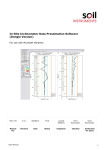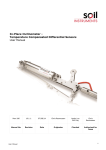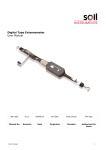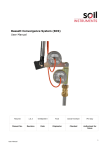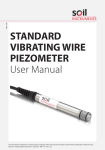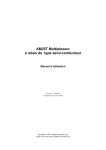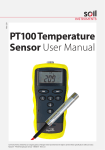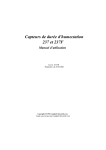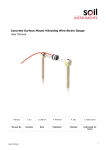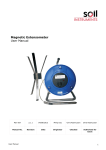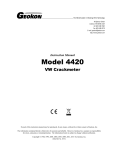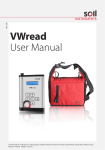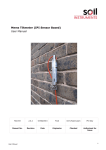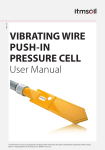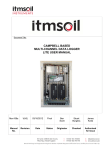Download MEMS BEAM SENSOR User Manual
Transcript
Man 246 MEMS BEAM SENSOR User Manual Soil Instruments Limited has an ongoing policy of design review and reserves the right to amend these specifications without notice. Man246 - MEMS Beam Sensor - MN1114 - Rev1.0.0 1 What’s this manual about? This manual tells you about the MEMS Beam Sensor and how to use it to measure vertical rotations of structures. Who does this apply to? Installers, field engineers and technicians who need to install and acquire readings from MEMS Beam Sensors. 2 Welcome! Thank you for choosing the MEMS Beam Sensor. This manual has been written to provide you with relevant information and to guide you in the best practice for the use and installation of a MEMS Beam Sensor in order for you to get the most out of our product. Please read this manual thoroughly before use to help avoid any problems and keep it handy when installing a MEMS Beam Sensor. MEMS Beam Sensor The MEMS Beam Sensor is designed to measure vertical rotations of structures. There are two options available for the MEMS Beam Sensor; a Standard Beam Sensor which is an independently cabled sensor that connects to a Datalogger or a Smart Beam Sensor which is an inter-connecting sensor. The Sensors are available in either aluminium or Glass Reinforced Plastic (GRP). Both sensor types deliver a large measuring range with high sensitivity and relative immunity from the effects of long cable lengths and require no zero level adjustment. Each sensor incorporates an on-board microprocessor which performs an automatic temperature compensation of the tilt (g) data, delivering reliable, accurate and stable data. The data can be directly imported into our web-based monitoring software, providing a near real time tilt data that is constantly updated and available to view from any PC or mobile device with an internet connection. 3 Contents PART I – OVERVIEW6 Introduction:8 Important Information8 Product8 Changes8 Warranty8 Disposal8 System Description:9 Things You Need to Know about MEMS Beam Sensors 9 Features9 Benefits9 Applications9 System Description10 System Components10 Smart MEMS Beam Sensor 10 Connection Box11 Standard MEMS Beam Sensor 11 Anchor Kit11 PART II – MEMS BEAM SENSOR INSTALLATION GUIDE 12 Installing a MEMS Beam Sensor 14 Smart MEMS Beam Sensor Installation 15 Wiring Table19 Standard MEMS Beam Sensor Installation 19 PART III - STANDARD MEMS BEAM SENSOR WIRING & PROGRAMMING GUIDE24 Wiring the Standard MEMS Beam Sensors 26 Overview26 Wiring Table26 Function Test27 Logger Programming27 Data Reduction28 PART V –APPENDICES30 Appendix A - Sample Installation Record Sheet 32 Appendix B – Sample Calibration Certificate 33 4 PRECISELY MEASURED instrumentation and monitoring 5 Part I – Overview 6 Contents This section contains the following topics. TOPIC Introduction: Important Information Product Changes Warranty Disposal System Description: Things You Need to Know about MEMS Beam Sensors Features Benefits Applications System Description System Components Smart MEMS Beam Sensor Connection Box Standard MEMS Beam Sensor Anchor Kit SEE PAGE 8 8 8 8 8 8 9 9 9 9 9 10 10 10 11 11 11 7 Introduction: Important Information The following symbols are used throughout this manual WARNING IMPORTANT INFORMATION TIP QUESTION ! Important: Failure to adhere to the warnings in this manual may result in network disruption and possible data loss. Failure to observe the warning may result in injury, product malfunction, unexpected readings or damage to the product that may invalidate its warranty. Tips give additional information that may be helpful when using a MEMS Beam Sensor. 8 PRODUCT CHANGES Soil Instruments Limited has an on-going policy of design review and reserves the right to amend the design of their product and this instruction manual without notice. WARRANTY Please refer to Soil Instruments Limited terms and conditions of sale for warranty information. Batteries are a consumable item and are excluded from any warranty. DISPOSAL Products marked with the symbol are subject to the following disposal rules in European countries: • This product is designated for separate collection at an appropriate collection point • Do not dispose of as household waste • For more information, contact Soil Instruments Limited or the local authority in charge of waste management. System Description: Things You Need to Know about MEMS Beam Sensors FEATURES • Inter-connecting Smart Sensors • Accurate and precise measurements using MEMS sensors • Multiple beams installed in a chain give a complete displacement profile • Measures tilt along the whole length of the beam • Measures vertical rotation • Large measuring range. BENEFITS • Fast onsite installation with minimal cable management; reduces cable and Datalogger costs • Easy to automate using data acquisition system and ‘ARGUS’ monitoring software • Removes the need for manual monitoring • Recoverable and reusable • Suitable for safety critical applications • Fast onsite installation; no zero level adjustment required. APPLICATIONS • • • • • • • • Brick and stone buildings Heave and settlement due to adjacent construction activities Bridges and dams Impounding and loading effects in the short or long-term Pipelines Differential levels Tunnels Vertical rotation and track deformation. 9 System Description The MEMS Beam Sensor measures rotation of structures in the vertical plane and is mounted horizontally in beams typically 1 to 2.5 metres in length. When multiple beams are placed end to end, a differential displacement profile of the structure from anchor point to anchor point can be derived. The diagram below depicts the positive (+) and negative (-) displacement of the MEMS Beam Sensor. System Components SMART MEMS BEAM SENSOR The Smart MEMS Beam Sensor operates on a single cable system. Each Beam connects to the next using an inter-connecting cable with a plug connection at the end which attaches to the opposing socket mounted within the next beam. Once the chain is complete, the final cable attaches to a connection box. A four core armoured cable then connects the connection box back to a Datalogger. Fork end fixing Protective housing Slot end fixing MEMS Sensor Inter-connecting plug 10 Cable Inter-connecting socket CONNECTION BOX The Smart Beam Sensor incorporates a cable and plug which connects each beam to the next, culminating in either a left or right hand connection box. Right Hand Connection Box Left Hand Connection Box Cable connector CANbus terminating plug Cable gland Mounting plate Flexible cable gland STANDARD MEMS The Standard MEMS Beam Sensor is supplied with a specified cable BEAM SENSOR length that is individually wired into a Datalogger. Both sensors are available in either aluminium or GRP (Glass Reinforced Plastic). Once installed, the sensors are ready to take measurements; no zero level adjustment is required. Fork end fixing Protective housing Cable ANCHOR KIT Slot end fixing MEMS Sensor The anchor kit supplied by Soil Instruments has either an expanding shell M10 anchor or a groutable M10 anchor. Groutable Anchor Standard nut Metal washer Lock nut Spacer washer Expanding Shell Anchor Standard nut Metal washer 11 Part II – MEMS Beam Sensor Installation Guide 12 Contents This section contains the following topics. TOPIC Installing a MEMS Beam Sensor Smart MEMS Beam Sensor Installation Standard MEMS Beam Sensor Installation Wiring Table SEE PAGE 14 15 19 19 13 Installing a MEMS Beam Sensor Follow the precautions outlined in this manual at all times to ensure the correct working order of your instrument. WARNING It is essential that the equipment covered by this manual is handled, operated and maintained by competent and suitably qualified personnel. IMPORTANT INFORMATION To guide you in the competence required for installing each instrument in our product range, Soil Instruments provide you with a recommended skill level in all of our manuals and datasheets. TIP Soil Instruments recommend an intermediate skill level for installing a MEMS Beam Sensor. The nominal beam length will have been specified at the time of ordering. The beam (gauge) length will be displayed on the sensor product label. IMPORTANT INFORMATION 14 SMART MEMS BEAM SENSOR INSTALLATION STEP To install a Smart MEMS Beam Sensor, follow the steps outlined below. ACTION 1 Hold the beam up against the structure to be monitored with a spirit level along the top face, level and mark the centre of each end fitting 2 Remove the beam and drill two holes to approximately 60mm depth. Once the hole has been drilled remove the excess dust from the hole. 3 Install the chosen anchor type. (Groutable anchor shown above) If using an expanding shell anchor, insert and set with a setting tool. If using a groutable anchor, grout and wait the required time for setting (with quick set adhesive such as Hilti HIT-HY 150 this is approximately thirty minutes at 20°C). TIP Take every precaution to ensure that the hole is drilled straight into the structure and not at an angle to it. WARNING 15 Before drilling the hole, measure the length of the shell anchor against the drill bit and mark the bit with tape to ensure you drill the whole to the correct depth. TIP Make sure the hole is drilled to the correct depth to receive the anchor. If the hole is too shallow, remove the anchor and carefully re-drill to the sufficient depth. If the hole is too deep, you will need to drill a new hole that is the correct depth. WARNING STEP 16 ACTION 4 Thread and secure an M10 nut on both anchors, followed by a metal washer. 5 On the first anchor that will accept the end beam, add two spacer washers with the inserts facing each other, followed by a metal washer and an M10 lock nut. STEP ACTION 6 On the second and subsequent anchors, add two spacer washers with the inserts facing each other, then add the further two spacer washers in the same manner, so the second and third washers are back to back, followed by a metal washer and an M10 lock nut. 7 Slide the left hand fork of the first beam between the two spacer washers so the fork is resting on the inserts of the washers. 8 Place the right hand slot fixing of the beam over the anchor, between the second set of spacer washers, so the slot is resting on the inserts of the washers. Place the fork end of the second beam between the first two spacer washers as before and repeat this process for all the subsequent beams. 9 Once the chain installation is complete, repeat step 2 for the final fixing of the end beam. 17 STEP 10 ACTION When all the beams within the chain are installed, connect each beam to the next using the inter-connecting plug, ensuring the connection is fully tightened. The nylock nut should be tightened so that the beams, including the end Beam, do not rattle around, but you should be able to move them back and forth with a small amount of force. WARNING STEP 18 ACTION 11 Check with a spirit level that both horizontal axis of the beam are level (i.e. both along and across the beam), it may be necessary to loosen the large bolt which attaches the end fitting to the beam by approximately one turn and rotate the beam to achieve the level. Once level, carefully re-tighten the end fitting bolts. 12 Install the Datalogger within a reasonable distance of the MEMS Beam Sensor using suitable fixings for the medium it is to be attached to. 13 Connect the CANbus terminating plug to the last beam in the array. 14 Connect the MEMS Beam Sensor into the connection box, then connect the armoured cable using the following wiring table. 15 Wire the armoured cable into the Datalogger. WIRING TABLE STANDARD MEMS BEAM SENSOR INSTALLATION STEP CONNECTION BOX DATALOGGER SIM ARMOURED CABLE CONDUCTOR COLOUR SW Power SW Power Brown Ground Ground Blue Can H Can H Grey Can L Can L Black Screen Screen Screen To install a Standard MEMS Beam Sensor, follow the steps outlined below. ACTION 1 Hold the beam up against the structure to be monitored with a spirit level along the top face, level and mark the centre of each end fitting 2 Remove the beam and drill two holes to approximately 60mm depth. Once the hole has been drilled remove the excess dust from the hole. 3 Install the chosen anchor type. (Groutable anchor shown above) If using an expanding shell anchor, insert and set with a setting tool. If using a groutable anchor, grout and wait the required time for setting (with quick set adhesive such as Hilti HIT-HY 150 this is approximately thirty minutes at 20°C). TIP 19 Take every precaution to ensure that the hole is drilled straight into the structure and not at an angle to it. WARNING Before drilling the whole, measure the length of the shell anchor against the drill bit and mark the bit with tape to ensure you drill the whole to the correct depth. TIP Make sure the hole is drilled to the correct depth to receive the anchor. If the hole is too shallow, remove the anchor and carefully re-drill to the sufficient depth. If the hole is too deep, you will need to drill a new hole that is the correct depth. WARNING 20 STEP 4 ACTION Thread and secure an M10 nut on both anchors, followed by a metal washer. 5 On the first anchor that will accept the end beam, add two spacer washers with the inserts facing each other, followed by a metal washer and an M10 lock nut. STEP 6 ACTION On the second and subsequent anchors, add two spacer washers with the inserts facing each other, then add the further two spacer washers in the same manner, so the second and third washers are back to back, followed by a metal washer and an M10 lock nut. 7 Slide the left hand fork of the first beam between the two spacer washers so the fork is resting on the inserts of the washers. 8 Place the right hand slot fixing of the beam over the anchor, between the second set of spacer washers, so the slot is resting on the inserts of the washers. Place the fork end of the second beam between the first two spacer washers as before and repeat this process for all the subsequent beams. 21 STEP ACTION Once the chain installation is complete, repeat step 2 for the final fixing of the end beam. 9 The nylock nut should be tightened so that the beams, including the end Beam, do not rattle around, but you should be able to move them back and forth with a small amount of force. WARNING STEP ACTION 10 Cable-tie the sensor cables to the beam leaving a suitable amount of slack at the joints to allow for movement. 11 Check with a spirit level that both horizontal axis of the beam are level (i.e. both along and across the beam), it may be necessary to loosen the large bolt which attaches the end fitting to the beam by approximately one turn and rotate the beam to achieve the level. Once level, carefully re-tighten the end fitting bolts. 12 Install the Datalogger within a reasonable distance of the MEMS Beam Sensor using suitable fixings for the medium it is to be attached to. 13 Wire the MEMS Beam Sensors into the Datalogger. Please refer to ‘Part III - Standard MEMS Beam Sensor Wiring and programming Guide’ in this manual for more details. Take extreme precaution when wiring the MEMS Beam Sensor to ensure the conductors are correctly wired into the Datalogger, especially the red power conductor and all of the output conductors. Always wire the sensor with the power switched off. WARNING 22 23 Part III Standard MEMS Beam Sensor Wiring & Programming Guide 24 Contents This section contains the following topics. TOPIC Wiring the Standard MEMS Beam Sensors Overview Wiring Table Function Test Logger Programming Data Reduction SEE PAGE 26 26 26 27 27 28 25 Wiring the Standard MEMS Beam Sensors Follow the precautions outlined in this manual at all times to ensure the correct working order of your instrument. WARNING OVERVIEW The Standard MEMS Beam Sensor can be read by most commercially available Dataloggers, however, Soil Instruments can supply a fully built and configured Datalogger with an enclosure, custom logging program and a variety of communications options from a simple direct link to satellite modem. Please refer to datasheet ‘D1 – Dataloggers’ for more details. Whatever the chosen reading method the sensor wiring remains the same. The cable has four conductors, and a shield. The shield is not connected at the sensor end of the cable and so should be connected to ground at the Datalogger for maximum resistance to induced voltages and interference. The sensor is a differential device, therefore a high and low reading must be taken. The conductor colour codes are detailed in the following table; Take extreme precaution when wiring the MEMS Beam Sensor to ensure the conductors are correctly wired into the Datalogger, especially the red power conductor and all of the output conductors. Always wire the sensor with the power switched off. WARNING WIRING TABLE CONDUCTOR COLOUR IDENTIFICATION Red Power+ (10-16V DC) Black Ground White Signal high Green Signal low Bare wire Screen (drain) The sensors are supplied with a 4 core cable with a polyurethane jacket. IMPORTANT INFORMATION 26 FUNCTION TEST It is recommended to carry out a function test of the sensors immediately after installation at zero degrees tilt the sensor output is approximately 0 VDC Once all the sensors have been wired into the Datalogger, apply power to the sensors and wait for 3 seconds. Take a minimum of 50 readings at differential voltage at a minimum 100 millisecond and then average these readings. • Power the sensors on and wait for 3 seconds • Take a minimum of 50 readings (differential voltage) at minimum 100 millisecond intervals • Average the readings. LOGGER PROGRAMMING Soil Instruments MEMS Beam Sensors are designed to be read by Campbell Datalogger systems. Other Dataloggers can be used, but the basic reading and excitation architecture outlined in this section must be followed. Sensors should be read via a multiplexer (Campbell AM416 or AM16/32) and the following sequence must be used to ensure best sensor performance: • Activate multiplexer • Switch to first channel a) Switch on power supply to sensor (Campbell loggers use the switched 12Volt option) b) Let the sensor warm up for at least 3 seconds c) Take a minimum of 50 differential measurements and store the average d) Switch power to the sensor off e) Switch to the next channel • Repeat step a) through e) for the next sensor • De-activate multiplexer Sensors can be left powered when not being read, however, for maximum life, this is not recommended. This is not possible when using multiplexer units, therefore, the above sequence should be observed. When long cable lengths are being used, ensure the settling time for the Datalogger measurements are increased to achieve optimal performance. TIP 27 If in any doubt, please contact Soil Instruments support for advice. The performance of the sensors as calibrated is not guaranteed unless the above protocols are used. WARNING Soil Instruments can supply full logger programs and wiring diagrams at an extra cost, please contact Soil Instruments support for details. TIP DATA REDUCTION The MEMS Beam Sensor is calibrated over ±10 arc degrees (approximately ±175mm/metre) and has a DC voltage output dependant on tilt. The calibration certificate supplied with the sensor contains the following information; • Instrument Type • Serial Number • Range • Calibration Data (both raw and reduced) • Conversion Formula • FS Error % at each calibration point • Wiring Code Please refer to ‘Appendix B – Sample Calibration Certificate’ in this manual for more details. The MEMS Accelerometer chip used in the Beam Sensor is calibrated for temperature as part of the micro-machine manufacturing process by the chip manufacturer. As well as the MEMS tilt element, the sensor contains a microprocessor and a look up table to apply correction for temperature changes to the silicon substrate within the sensing element. Soil Instruments has no control over this process other than by the QA procedures followed by the chip manufacturer, which specify the correction and rejection criteria. The sensor output is therefore corrected automatically for the effects of temperature on the accelerometer chip. Soil Instruments do not offer the sensor with an on-board temperature sensor. If temperature measurement is desired, then a separate temperature sensor must be installed additional to the Beam Sensor. 28 29 Part V – Appendices 30 Contents This section contains the following topics. TOPIC Appendix A - Sample Installation Record Sheet Appendix B – Sample Calibration Certificate SEE PAGE 32 33 31 Appendix A - Sample Installation Record Sheet MEMS BEAM SENSOR INSTALLATION RECORD SHEET Date: Length: Site: String No: Location: Hz/V/Tilt: Installed By: No. Of Sensors: Location 32 Sensor number Serial number Gauge length Mux number Mux Channel Data Logger Notes Appendix B – Sample Calibration Certificate 33 SUPPORT www.itmsoilsupport.com +44 (0) 1825 765044 34 35 Bell Lane, Uckfield, East Sussex TN22 1QL United Kingdom t: +44 (0) 1825 765044 f: +44 (0) 1825 744398 e: [email protected] w: www.soil.co.uk Soil Instruments Ltd. Registered in England. Number: 07960087. Registered Office: 3rd Floor, 17 Hanover Square, London W1S 1HU 36





































